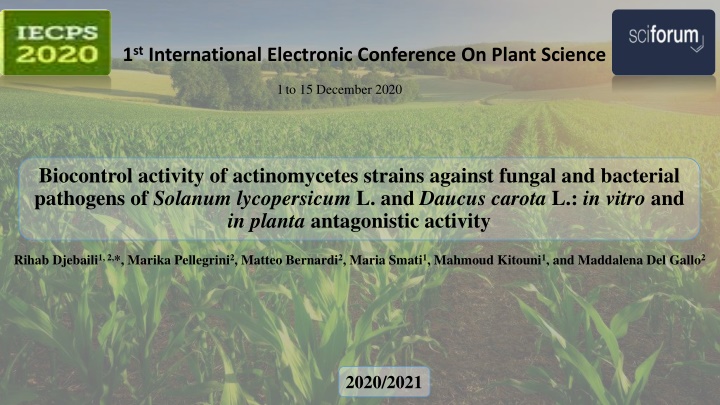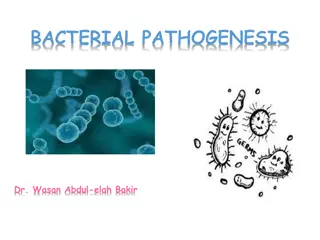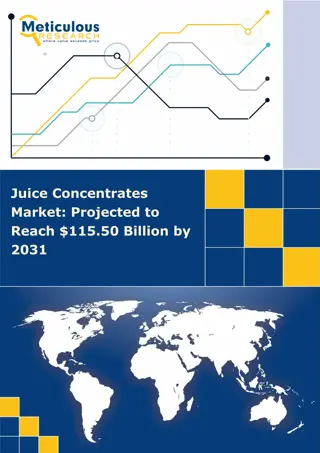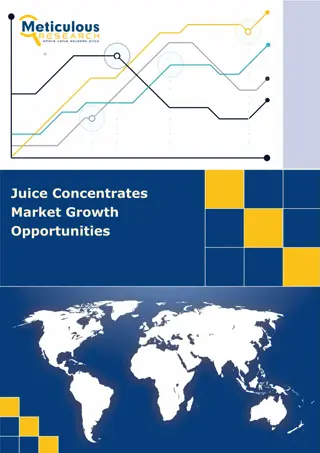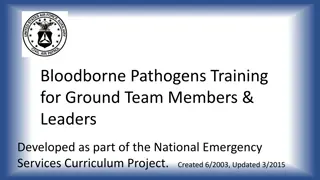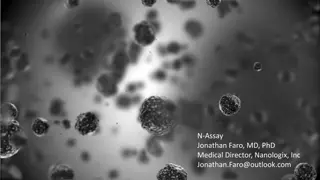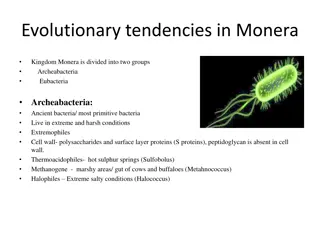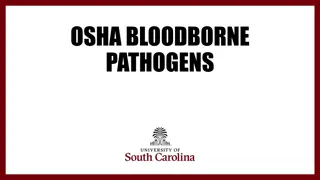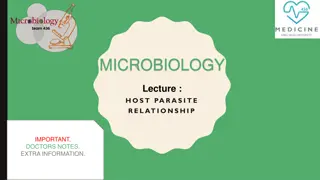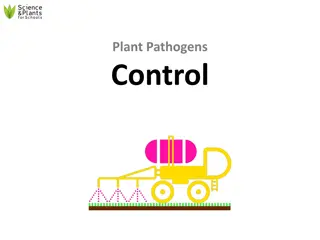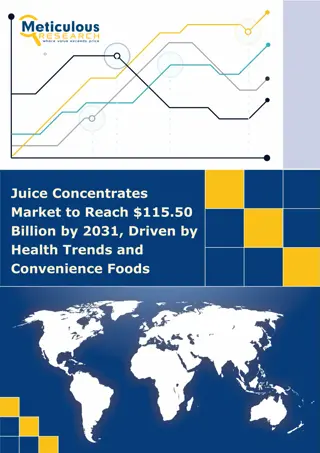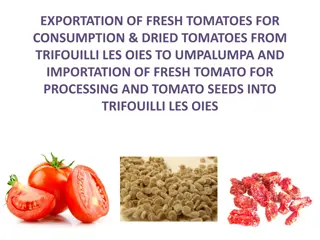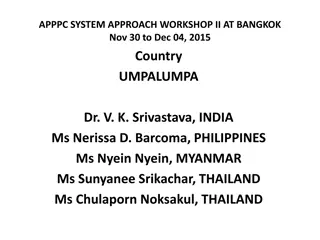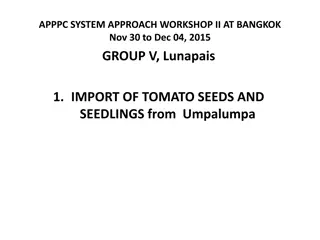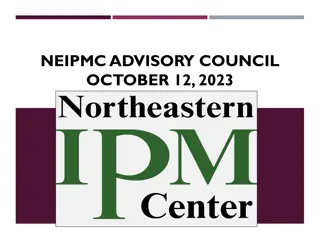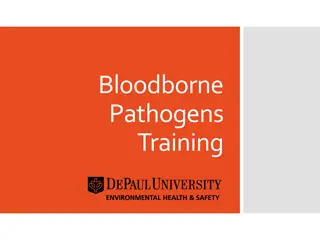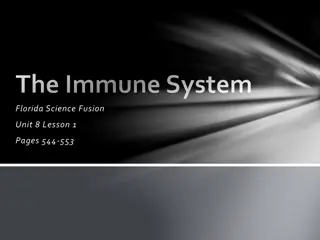Biocontrol Activity of Actinomycetes Against Pathogens of Tomato and Carrot
Plants face various stresses due to climate change, making them vulnerable to pathogens. Actinomycetes, such as Streptomyces, are beneficial soil bacteria with antimicrobial properties that can promote plant growth and suppress diseases. Research explores their antagonistic activity against fungal and bacterial pathogens of Solanum lycopersicum and Daucus carota, demonstrating their potential as biocontrol agents in agriculture.
Download Presentation

Please find below an Image/Link to download the presentation.
The content on the website is provided AS IS for your information and personal use only. It may not be sold, licensed, or shared on other websites without obtaining consent from the author.If you encounter any issues during the download, it is possible that the publisher has removed the file from their server.
You are allowed to download the files provided on this website for personal or commercial use, subject to the condition that they are used lawfully. All files are the property of their respective owners.
The content on the website is provided AS IS for your information and personal use only. It may not be sold, licensed, or shared on other websites without obtaining consent from the author.
E N D
Presentation Transcript
1stInternational Electronic Conference On Plant Science 1to 15 December 2020 Biocontrol activity of actinomycetes strains against fungal and bacterial pathogens of Solanum lycopersicum L. and Daucus carota L.: in vitro and in planta antagonistic activity Rihab Djebaili1, 2,*, Marika Pellegrini2, Matteo Bernardi2, Maria Smati1, Mahmoud Kitouni1, and Maddalena Del Gallo2 2020/2021
Introduction -Plants are affected by different biotic and abiotic stresses due to climate change. -Increasing in temperature make plants susceptible to pathogens attack. -Tomatoes and carrots are important crops most consumed worldwide for their nutritional values, these vegetable crops are attacked by several pathogens which limit their growth and productivity. -Several rhizospheric microorganisms have the ability to promote plant growth, and have antagonistic properties against pathogens attack, and play a role in disease control. -Plant growth-promoting rhizobacteria (PGPR) have a beneficial effects on plants by direct and indirect mechanisms; phosphate solubilization, siderophores production, nitrogen fixation, the activity of 1- aminocyclopropane-1-carboxylate deaminase enzyme, fixation of atmospheric nitrogen, phytohormones and plant growth regulators production, protection against phytopathogens by systemic resistance (SRI) induction. (Nawaz et al., 2020; Orio et al., 2016; Pagnani et al., 2018)
Actinomycetes are a group of filamentous bacteria widely distributed in soil, GRAM positive, with a high percentage of GC, they are resistant microorganisms, can sporulate when environmental conditions become unfavorable. They have the capacity to produce various metabolites, hydrolytic enzymes and to degrade recalcifying materials. The genus Streptomyces is the most reactive, it is responsible of a wide range of antibiotic production. It constitutes an important group of microorganisms due to their antimicrobial power, dominance in soils and their promotion of plant growth. They have the ability to inhibit a large spectrum of pathogenic bacteria, and several traits promoting plant growth and suppress plant diseases. (Gowdar et al., 2018)
Stimulation of plant growth includes hormones, and plant growth regulators production such as indole acetic acid (IAA) and cytokinin which are involved in root development, exudation and plant growth. these bio-stimulators and biocontrol agents represent a substitute for harmful chemical pesticides for achieving the quest for sustainability in agriculture. (Gowdar et al., 2018)
Experimental part In vitro antagonistic activity of diffusible and volatile compounds was carried out by dual culture method against Fusarium oxysporum f. sp. radicis-lycopersici (FORL), and Rhizoctonia solani (RHS). PGPB-fungus interaction zone were analyzed by SEM microscopy. The pathogenic bacteria tested were: Pseudomonas syringae, Pseudomonas corrugata, Pseudomonas syringae pv. actinidiae, Pectobacterium carotovorum subsp. Carotovorum. The inhibition percentages were calculated after incubation until the complete growth of the control plate. (Chauhan et al., 2016; Kitouni et al., 2005; Pellegrini et al., 2020)
Results Strains H12 (Streptomyces albidoflavus), and H14 (Nocardiopsis aegyptica) showed good in vitro antagonistic activity by diffusible and volatiles compounds against both pathogens (inhibition percentage up to 85%). Figure1. Antagonistic activity by diffusible and volatile compounds by dual culture method. (A) diffusible compounds. (B) volatiles compounds. (C) normal growth of fungul strain.
Figure 2. SEM micrographs of FORL and RHS hyphae. The panels show the fungal hyphal branching following a normal growth in FORL and RHS control plates (A and B, respectively). In the presence of H12 and H14 consortium, the hyphal structures change in the interaction zones of both FORL and RHS with the PGPB (C and D, respectively).
Strains H12, and H14 showed good antibacterial activity against Pseudomonas corrugate, and Pectobacterium carotovorum (inhibition diameter 10mm). The CFCs of combined strains were investigated for cell-free supernatant (CFS) Minimal Inhibitory Concentration (MIC) and Minimum Bactericidal Concentration (MBC). The CFSs (up to 0.8 %) was effective to inhibit the growth of both FORL, and RHS fungi and most of the bacterial pathogen growth. (Wayne, 2011)
In planta antagonistic activity of H12 and H14 consortium was assessed on S. lycopersicum, and D. carota in pre-emergence. The experiment was organized as follows: (i) CNT (seeds without PGPB/infection), PGPB (seeds with PGPB/no infection), PGPB+INF (seeds with PGPB/infection), INF (seeds with infection/no PGPB). The induced protection was assessed by estimation of plant survival, morpho- biochemical parameters, damages and chlorophyll contents. (Pellegrini et al., 2020)
Table1. Results of in planta pre-emergence (PRE) antagonistic activity of bacterial consortium (PGPR) against fungul and bacterial strains. S. lycopersicum D. carota Parameters CNT PGPR PGPR+F F CNT PGPR PGPR+F F Germination 80 100 73 53 88 100 48 29,3 damages 0 0 4 4 0 0 48 3,6 Plant height 6,5 10,9 7 4 4,5 5,4 4,6 3,4 Root length 1,1 2,8 1,8 1,2 1,7 1,9 1,4 1,04 leaves 2,6 5,1 3,7 2,5 2,0 3,0 2,3 1,6 Chlo (a+b) 3,39 9,42 4,46 1,6 4,93 15,54 6,1 2,4
Inoculation with the consortium (PGPB) improved development and growth of both tomato and carrot plants compared to the control (better germination rates, morpho- physiological characters, and chlorophyll content). Infection decreased germination rates, growth parameters, and total chlorophyll content, and caused damages with extension up to 20mm in uninoculated plants (INF). Treatment with the consortium improved germination in infected plants (PGPB+INF) up to 15-54% for tomato, and up to 30-100% for carrots. The presence of PGPB also alleviated infection symptoms; PGPB+INF plants showed less damages, and better chlorophyll content than the control (p <0.05).
Conclusions and perspectives Plant growth promoting traits of actinomycetes strains act indirectly in the control of plant diseases. The use of combined bacteria is a strategy for plants protection against pathogens attack. Actinobacteria are well known for their ability to produce various bioactive compounds, they are biological agents for their antagonistic activities, and plants protection against several soil borne pathogens. The actionmycetes strains investigated in this study also have different plant growth-promoting traits. These traits enhance plant physiological status and offer an additional advantage to their use as biological control agents for sustainable agriculture. Further experiments are needed to determine their effectiveness on other plants, against other pathogens and under different cultivation conditions. However, these preliminary results underline that actinomycetes, and in particular Streptomyces and Nocardiopsis genera, can be biological alternatives for plants disease management. (Djebaili et al., 2020; Pellegrini et al., 2020)
